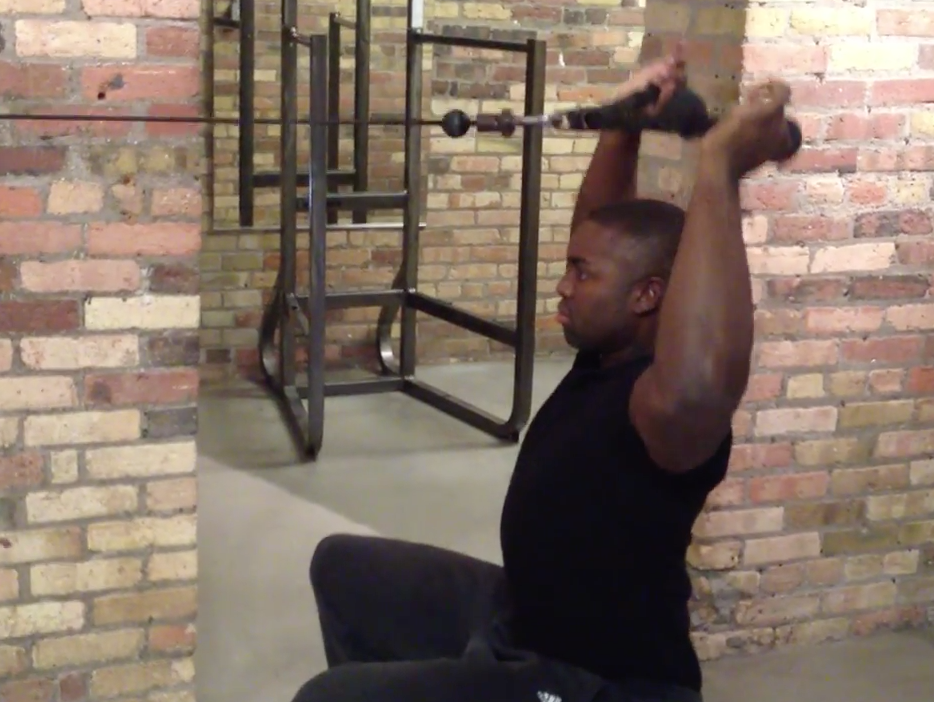
Exercise of the Week: Resisted Scapular Wall Slides
Today’s “Exercise of the Week” guest post comes from Lee Boyce. Enjoy! -EC
One of the basic exercises that people are taught to practice for improved shoulder rotation, upper back activation, scapular mobility and anterior muscle release as a by-product is the standard scapular wall slide. To do them, a lifter would simply stand with the heels, butt, upper back, shoulders and full arms and hands against the wall, reduce the lower back arch, and slide the hands up and down, mimicking a full shoulder press movement pattern.
Regressing this movement is as simple as taking the feet a few inches away from the wall and assuming position otherwise. Progressing this movement, however, is another story.
The problem is that people adapt quickly to an unloaded mobility drill, and because of this, the wall slide can become another non-transferrable “skill” that doesn’t carry over to generally improved posture or performance. Moreover, depending on whether the humerus is properly nested in the glenoid fossa to begin with, the wall slides themselves may always pose a problem from a biomechanical perspective. To help this cause, adding some mild resistance can “remind” the muscles of the rotator cuff to center the humeral head in the socket and create a much more effective external rotation position. Plus, using a neutral grip via ropes (as compared to a palms-forward grip) creates a much more ideal (and shoulder friendly) environment for external rotation that can act to counter anterior shoulder glide.
For resisted scapular slides, I like using a cable pulley, and performing the lift from a seated position. It’s a bit easier for a lifter to focus on avoiding back hyperextension, which is a common compensation pattern when lifters have insufficient shoulder mobility.
This movement creates a force angle that works against the standard slide pattern, so keeping the hands and arms moving along the same plane becomes a much more challenging task for the scapular muscles. It’s easy to “let up” and allow the hands and arms to drift forward. To view the movement in action, watch the video below.
Coaching Cues
1. Have the athlete sit squarely on a box or bench. The closer parallel the box puts him in, the better.
2. Set up the cable pulley and ropes in a position just above head level. This way, at the top position, the force angle won’t be strictly downward, and there will be ample tension throughout.
3. If the lifter is still novice or intermediate level as far as shoulder mobility and control goes, a neutral grip is recommended for reasons mentioned above. If the lifter is more advanced, he can feel free to pinch-grip between the thumb and first finger, and face the palms forward.
4. During the movement, avoid slipping into lower back hyperextension; maintain thoracic region extension; and be sure to maintain neutral head posture. Also, avoid letting the elbows fall out of line with the hands in the vertical plane.
5. Your target areas are the rotator cuff muscles, rear deltoids, and lower traps (as you raise the weight further overhead). When you start feeling this in other areas like the biceps and upper traps, readjust positioning and continue.
6. The exercise is very specific, so it shouldn’t take much weight for it to be effective. 15-20lbs of resistance on most machines is usually plenty.
7. The movement won’t work if it’s done in a rush. Think of a 2121 tempo as a solid guideline.
8. Use higher reps to build up the muscular endurance of these muscle groups.
9. Your range of motion should replicate your typical dumbbell shoulder press – meaning the rep begins very close to the shoulder level, and ends at a full arm extension overhead.
10. Through the movement, remember to keep the hand separated (pull the rope handles apart) as much as possible. Doing so keeps the upper back engaged, avoids internal rotation, and keeps the hands stacked over the shoulder, where they belong.
About the Author
Lee Boyce (@CoachLeeBoyce) is a strength coach, writer, and former collegiate level sprinter and long jumper, based in Toronto, Canada. In 2013, he was named to the training and treatment staff for team Jamaica at the Penn Relays . He’s regularly featured in the largest fitness publications as a writer. Visit his website at www.LeeBoyceTraining.com or check him out on Facebook.


